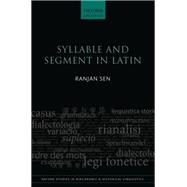Syllable and Segment in Latin

Syllable and Segment in Latin
- ISBN 13:
9780199660186
- ISBN 10:
0199660182
- Format: Hardcover
- Copyright: 04/26/2015
- Publisher: Oxford University Press
.svg) Rent
From $114.57
Rent
From $114.57
List Price $165.33 Save
| TERM | PRICE | DUE |
|---|---|---|



List Price $165.33 Save $1.65
Usually Ships in 3-5 Business Days
We Buy This Book Back!
Free Shipping On Every Order
Note: Supplemental materials are not guaranteed with Rental or Used book purchases.
Extend or Purchase Your Rental at Any Time
Need to keep your rental past your due date? At any time before your due date you can extend or purchase your rental through your account.
Summary
Ranjan Sen considers examines clear and dark /l/; inverse compensatory lengthening; syllabification before stop + liquid in vowel reduction; vocalic epenthesis in stop + /l/; and consonantal assimilations. He ascertains the phonological conditions for each phenomenon, reconstructs the motivations for the changes, and develops a methodology for the appropriate use of evidence from non-current languages to evaluate theories of diachronic phonology. He evaluates the likely phonetic and phonological influences by investigating studies across languages, establishing a secure evidence base through detailed philological examination, and reconstructing the phonetics - through both general principles and pertinent experimental studies - and the relevant phonological structure of the language.
The book will appeal to graduate students and researchers in historical linguistics, phonology, Classical philology, and Indo-European linguistics.






